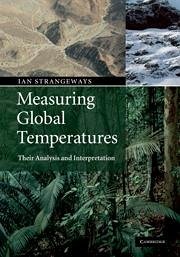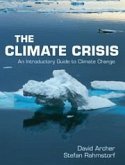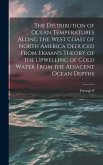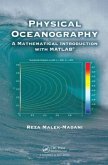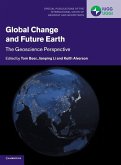- Gebundenes Buch
- Merkliste
- Auf die Merkliste
- Bewerten Bewerten
- Teilen
- Produkt teilen
- Produkterinnerung
- Produkterinnerung
An explanation of how global temperatures are measured and analysed, for meteorologists, climatologists and hydrologists.
Andere Kunden interessierten sich auch für
![The Climate Crisis The Climate Crisis]() David ArcherThe Climate Crisis138,99 €
David ArcherThe Climate Crisis138,99 €![A Cultural History of Climate A Cultural History of Climate]() Wolfgang BehringerA Cultural History of Climate24,99 €
Wolfgang BehringerA Cultural History of Climate24,99 €![A Cultural History of Climate A Cultural History of Climate]() Wolfgang BehringerA Cultural History of Climate75,99 €
Wolfgang BehringerA Cultural History of Climate75,99 €![The Distribution of Ocean Temperatures Along the West Coast of North America Deduced From Ekman's Theory of the Upwelling of Cold Water From the Adjacent Ocean Depths The Distribution of Ocean Temperatures Along the West Coast of North America Deduced From Ekman's Theory of the Upwelling of Cold Water From the Adjacent Ocean Depths]() George F McEwenThe Distribution of Ocean Temperatures Along the West Coast of North America Deduced From Ekman's Theory of the Upwelling of Cold Water From the Adjacent Ocean Depths27,99 €
George F McEwenThe Distribution of Ocean Temperatures Along the West Coast of North America Deduced From Ekman's Theory of the Upwelling of Cold Water From the Adjacent Ocean Depths27,99 €![Physical Oceanography Physical Oceanography]() Reza Malek-MadaniPhysical Oceanography111,99 €
Reza Malek-MadaniPhysical Oceanography111,99 €![The impact of urban expansion on land surface temperatures in Sulaymaniyah City The impact of urban expansion on land surface temperatures in Sulaymaniyah City]() Pakiza SaiedThe impact of urban expansion on land surface temperatures in Sulaymaniyah City47,95 €
Pakiza SaiedThe impact of urban expansion on land surface temperatures in Sulaymaniyah City47,95 €![Global Change and Future Earth Global Change and Future Earth]() Global Change and Future Earth125,99 €
Global Change and Future Earth125,99 €-
-
-
An explanation of how global temperatures are measured and analysed, for meteorologists, climatologists and hydrologists.
Produktdetails
- Produktdetails
- Verlag: Cambridge University Press
- Seitenzahl: 252
- Erscheinungstermin: 14. Dezember 2009
- Englisch
- Abmessung: 246mm x 175mm x 15mm
- Gewicht: 658g
- ISBN-13: 9780521898485
- ISBN-10: 052189848X
- Artikelnr.: 28109001
- Herstellerkennzeichnung
- Libri GmbH
- Europaallee 1
- 36244 Bad Hersfeld
- gpsr@libri.de
- Verlag: Cambridge University Press
- Seitenzahl: 252
- Erscheinungstermin: 14. Dezember 2009
- Englisch
- Abmessung: 246mm x 175mm x 15mm
- Gewicht: 658g
- ISBN-13: 9780521898485
- ISBN-10: 052189848X
- Artikelnr.: 28109001
- Herstellerkennzeichnung
- Libri GmbH
- Europaallee 1
- 36244 Bad Hersfeld
- gpsr@libri.de
Ian Strangeways obtained his degree in electronic engineering, physics and mathematics from Bangor University, followed by a PhD in meteorological instrumentation from Reading University. After 24 years at the Institute of Hydrology as head of the Applied Physics Section, concerned with measuring the hydrometeorological environment, he became Director of TerraData, a consultancy in meteorological and hydrological data collection. He is also the author of Measuring the Natural Environment, now in its second edition (2003, Cambridge University Press) and Precipitation: Theory, Measurement and Distribution (2007, Cambridge University Press). He has written many papers on the topic of data collection, climate measurement and instrumentation, and has written extensively for the Royal Meteorological Society's (RMetS) magazine Weather, for which he received the Gordon Manley Award in 2005. He is on the committee of the RMetS Special Interest Group on Meteorological Observing Systems, which he also chaired for three years. He has travelled extensively to many remote areas of the world, advising on the monitoring of the weather and rivers, and has given talks at major international conferences. He has been an external lecturer on the subject at Newcastle University, and has also taught at the Open University and instructed students overseas. He is an Associate Fellow of the RMetS and an Associated Member of the British Hydrological Society and the Institution of Civil Engineers.
Preface
1. The balance of energy
2. Thermometry
3. Screens, stands and shelters
4. Measuring land surface air temperatures
5. Measuring sea surface and marine air temperatures
6. Measuring sea temperature profiles
7. Global instrument networks
8. From point measurements to global means
9. Temperature changes since 1850
10. Temperature profiles through the atmosphere
11. Future measurements
Appendix A. The gas laws
Appendix B. Relative humidity and dew point
Appendix C. The electromagnetic spectrum
Appendix D. Satellite measurements of surface temperature
Appendix E. Metadata
Appendix F. The southern oscillation index
Index.
1. The balance of energy
2. Thermometry
3. Screens, stands and shelters
4. Measuring land surface air temperatures
5. Measuring sea surface and marine air temperatures
6. Measuring sea temperature profiles
7. Global instrument networks
8. From point measurements to global means
9. Temperature changes since 1850
10. Temperature profiles through the atmosphere
11. Future measurements
Appendix A. The gas laws
Appendix B. Relative humidity and dew point
Appendix C. The electromagnetic spectrum
Appendix D. Satellite measurements of surface temperature
Appendix E. Metadata
Appendix F. The southern oscillation index
Index.
Preface
1. The balance of energy
2. Thermometry
3. Screens, stands and shelters
4. Measuring land surface air temperatures
5. Measuring sea surface and marine air temperatures
6. Measuring sea temperature profiles
7. Global instrument networks
8. From point measurements to global means
9. Temperature changes since 1850
10. Temperature profiles through the atmosphere
11. Future measurements
Appendix A. The gas laws
Appendix B. Relative humidity and dew point
Appendix C. The electromagnetic spectrum
Appendix D. Satellite measurements of surface temperature
Appendix E. Metadata
Appendix F. The southern oscillation index
Index.
1. The balance of energy
2. Thermometry
3. Screens, stands and shelters
4. Measuring land surface air temperatures
5. Measuring sea surface and marine air temperatures
6. Measuring sea temperature profiles
7. Global instrument networks
8. From point measurements to global means
9. Temperature changes since 1850
10. Temperature profiles through the atmosphere
11. Future measurements
Appendix A. The gas laws
Appendix B. Relative humidity and dew point
Appendix C. The electromagnetic spectrum
Appendix D. Satellite measurements of surface temperature
Appendix E. Metadata
Appendix F. The southern oscillation index
Index.

